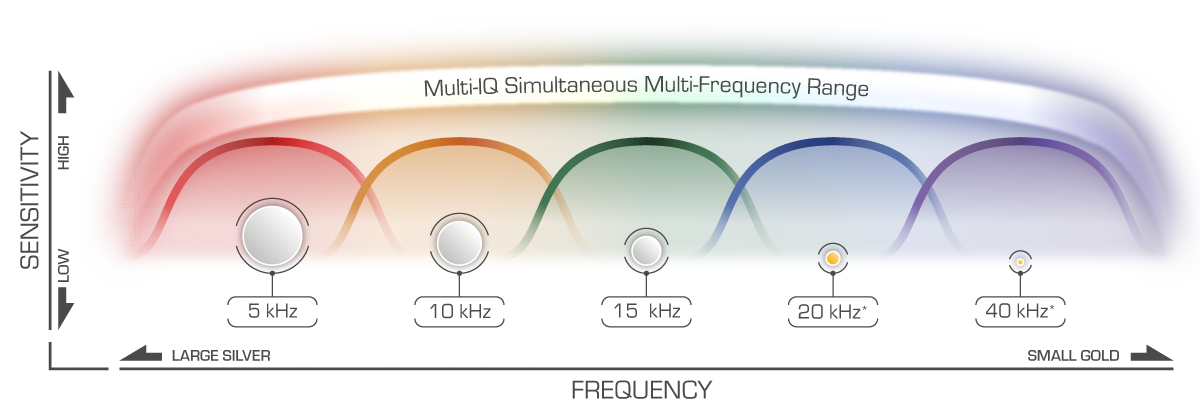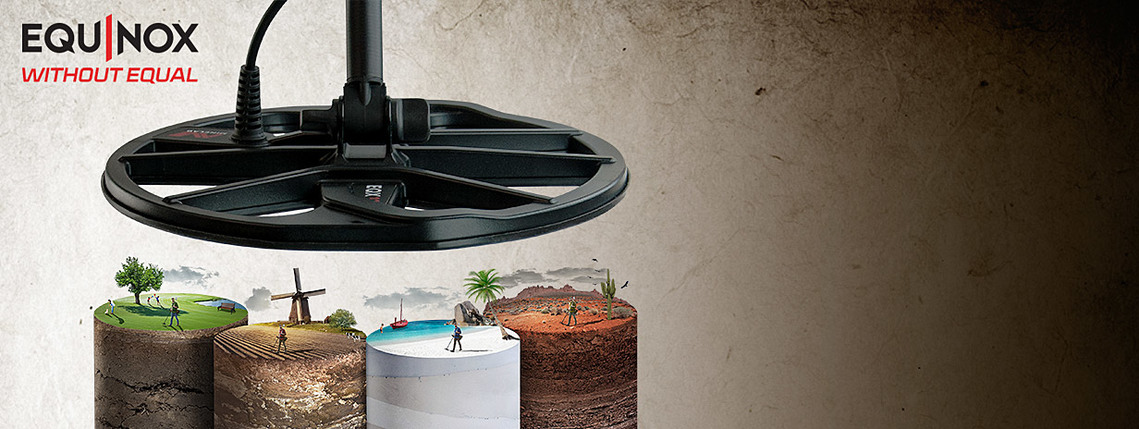Super, díky i za předchozí (a budoucí) díly
Minelab Equinox - down to the last screw, part 3
Categories: Minelab Equinox 800 and 600 metal detector

If you want to get the most out of your detector, you can only do so if you know how it works inside. That's why we've prepared a little series where we're going to break down the features of Multi IQ technology to the last detail while trying toto make it understandable for complete beginners and people with no technical talent, but also for other users who already have some experience with Equinox.
This is actually quite an unusual format, which is missing among many other videos about detectors working with Multi IQ technology. Actually we were led to it by the constant copying of settings from other users, without knowing what the settings actually do. Of course, copying settings optimized for a certain kind of terrain or target is not going to meet with success everywhere.
In the following series, we will discuss the complete Equinox setup in detail and justify what works where and how, what is optimal for a given type of search, and why to use this setup, for example.
The series will be beneficial for both Equinox users and Vanquish users, which is actually a derivative of Equinox using the same Multi IQ technology and the detectors are quite similar technologically.
We'll start from the very beginning and be as semi-literate as possible, so that it will be beneficial to both first time users and others who have been using the detector for a while. That's why you'll be able to look forward to a new episode every Monday, where we'll get deeper and deeper into the bowels of Equinox.

Episode 3: Treacherous Gold
Since therewas quite a bit of discussion around the first episode, which is a good thing, we decided to insert some more interesting experiments into the third episode regarding the dependence of ID number on material and area. After the questions in the discussion and the dependence on material thickness, which we neglected in the first part, because basically from 1mm material thickness onwards it will show very little.
Logically, when you consider that today it is no problem to coat glass with such a weak layer that you can see through it. And there is not even 1g of material on a glass with a huge surface area. So the logical assumption is that in order to be detected at all, more material is a necessity. So today, you'll see how the strength of the material on the ID shows up on three targets. The first will be tinfoil glued to a cardboard box (just to keep it from warping) as the second will be a really weak sheet of about 0.2mm from a Kozlo can and the third will be a classic aluminum 10 cent piece for comparison.
Another very interesting test will be for gold, because as a rule, when I post some gold from water on my FB group, the very second comment is what ID it had. However, you will see in the video that it is completely irrelevant information. I purposely picked the two most similar wedding bands with the same purity and virtually the same dimensions and a weight difference of about 0.2g. The only difference is that one is red gold and the other is white gold. And the difference in ID is almost double. So as I say, gold is tricky and consider that it is usually made in several purities from 8K to 18K.
The last one is an experiment with knocking down lead shot, there you can see that increasing the surface area raises the range and increases the ID number a bit. Be careful though, if you tap it too thin, the tinfoil effect will show up and the ID will go down again.
The bonus part is about the Pinpoint function
Actually, we made the video to make our job a bit easier, as we get about 5 calls every week on this topic. So in the video you'll see how the feature works and how to use it and what to avoid.
Jaccob
The article is included in categories:
- Archive of articles > Metal Detectors - Reviews and Tests > Minelab – tests and reviews > Minelab Equinox 800 and 600 metal detector
Post
diky super
Jaccob, opět palec nahoru 👍
Děkuji 😉
Myšák - podívej se ještě jednou na video. Tam je vidět že stupnice není lineární a v oblasti od 0+ je rozlišení daleko jemnější než od třeba 30+. a v intervalu kde vychází naprostá většina cílů je i rozlišení jemnější.
Každopádně EQ má 50 hodnot , osobně by mě stačilo klidně dohromady 20. Protože kdo přebírá cíle podle ID většinou h****no najde:D Sám si viděl jak na průměrém zlatém snubáku uděláš klidně dvojnásobný rozdíl ID podle toho jestli je z červeného nebo bílého zlata.
Další věc je že třeba levnější jednofrekvenční detektory mají rozptyl hodnot na jeden cíl třeba cca 50-70 v přibližně 1/2 užitné hloubky a dál s přibývající hloubkou se rozptyl ještě zvyšuje. Tak k čemu je ti rozlišení 0-99:D Prostě reálné měření není tak přesné aby mělo smysl ho rozdělit do tak přesné stupnice. Je to jako kdyby jsi měl kalkulačku schopnou počítat na 1 desetině místo a osadil jí displejem co jich má 6. Krom toho rozdíl ID si uděláš i natočením toho samého cíle vuči sondě. stejně tak jinak chodí sežranej 2haller a jinak 2 netknutej 2 haller z pískového pole.
Zdravím mám jen dotaz proč pinpoint je nastavane na tak velkou hlasitost je to až nepříjemné nejde to ztlumit.Co dat podnět do továrny aby stim něco pořešily třeba v další aktualizaci dik. 
Dukina, hlasitost funkce pinpoint je uměrná nastavené hlasitosti v detektoru. Nepřijde mi že by byl hlasitější jak klasické pohybové režimy akorát se to může zdát tím jak ten ton pinpointu je stálý kdežto v pohybových režimech je krátký, ale kdyby jsi změřil výšku amplitudy audio signálu bude stejná v obou režimech.
Super, tedy spíš se těšim na díly kde se budou rozebírat jednotlivé režimy, tedy pokud se taková série chystá. Jedinou výtku co bych měl, tak je, že aby bylo rozumět co povídáš, tak musim dát volume doprava a pak proti tomu je fakt kravál z detíku až úplně nepříjemnej... Těšim se na další díl 
Lucky lucky,neboj za chvili se dockas,tendle dil tam puvodne byt uplne nemel ale protoze se okolo toho tematu ID z prvniho dilu strhnula celkem velka diskuse tak bylo potreba odpobedet na vetsinu otazek aby ses k tomu pak nemusel vracet a mohl se posunout dal.
Jaccob - je evidentní, že stále omýlané ID je jen přibližné ukazovátko na materiál a cca velikosti cíle pod cívkou. V podstatě je to jen barevná hudba, která reaguje na výšku tónu danou materiálem, jejich směsici a množství odraženého signálu. Pro někoho by bylo jednodušší tam mít 3barevnou LEDku a tři tóny - železo, barva, bordel...:o)).
Ne, vážně.
To že se Ti hlásí každý ze snubáků jinak, je jistě dáno materiálem, jeho elektr. a možná i magnetickými vlastnostmi. Nejde srovnávat jen tvar a to že je tam zlato.
To je jako bys porovnával dvě brunetky ale jedna je při tom jen obarvená blondýnka (nic proti blondýnkám).
Už se těším na další odhalení tajemství našich detektorů.
Hlavně na systém, jakým vyhodnocuje cíle a na porovnávací tabulku ve stylu :
Když tohle je pod cívkou, takovéto půdní podmínky, tak tohle ukáže detektor - ID-zvuk, ....
a co se dá nastavit, aby to bylo průhledné a jasné. Tedy aspoň to, jak to výrobce myslel při konstrukci. Pokud se s tím výrobce chtěl podělit.
Tak uka...co máš pro nás dalšího...
Mysak, vystřihni si nějakou červenou folii a dej si ji na display a máš po bílé tmě. Je pravda, že ta bílá je fakt blbá i na nejslabší režim.











